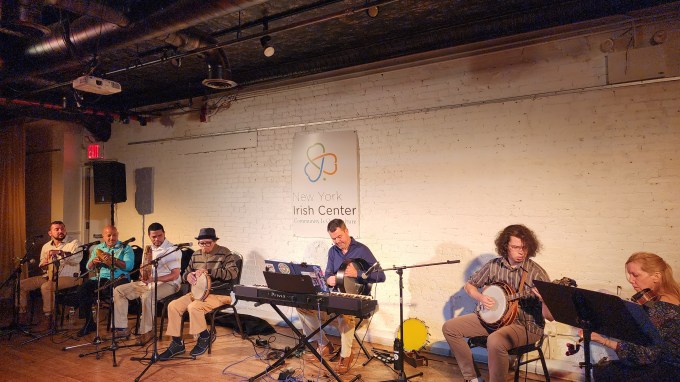
Irish and Puerto Rican musicians perform at the inaugural Crossroad Concert at the New York Irish Center. Photo: Shane O’Brien
Oct. 28, 2024 By Shane O’Brien
Irish traditional music met Puerto Rican plena at the New York Irish Center Thursday night as part of the organization’s new “Crossroads Concerts” series, fusing traditional Irish music with cultures from around the world.
The series, which features a total of seven concerts between Thursday’s launch event and June next year, pairs traditional Irish musicians with New York-based musicians representing cultures from all around the world. Thursday’s opening performance took place in the primary event’s space at the Irish Center, located at 10-40 Jackson Ave.
The inaugural event on Thursday began with a demonstration of the jigs and reels of traditional Irish music, featuring Dylan James on banjo, Bernadette Fee on fiddle and Colin Harte, curator of the series, on piano and bodhrán (a traditional Irish percussion instrument).
The Plena All-Stars, an ensemble of Puerto Rican artists featuring Jorge Vazquez, Carlos Espada, Victor Pablo and Joseito Rivera, then provided an interactive demonstration of traditional Puerto Rican plena music, explaining the cultural significance of plena and encouraging the audience to sing along to some of the catchier numbers.
The evening finished with a combined performance from all seven musicians, starting with a slow piece from Fee and James before evolving into a spontaneous and colorful back-and-forth between both sets of musicians that lasted roughly 20 minutes.

Photo: Shane O’Brien
By the end of the vibrant performance, Fee had cast her fiddle aside to provide a demonstration of traditional Irish dance, while Rivera danced with a member of the audience brought to her feet by the performance. The performance ended with all seven musicians on their feet, dancing and playing as the audience clapped along.
Thursday’s concert explored the differences and similarities between traditional Irish music and Puerto Rican plena, exploring the cultural impact that the two music styles still have on Ireland and Puerto Rico.
Harte, the curator of the Crossroads Concerts series and a musicologist at Bard High School Early College in the Bronx, said the series is a classic New York experience, allowing audience members to see two different cultures side by side.
“Some people will come in and know one tradition or the other,” Harte said. “This way, you get to hear another tradition, and then you get the classic New York experience – what happens when they come together side by side?”
Harte said he was inspired to create the cross-community series while teaching in the Bronx, stating that he would often invite musicians representing a wide variety of cultures to engage with his students. While those musicians were performing and teaching his students, Harte was mentally fusing their music with traditional Irish music.
Harte put the idea into practice when a Ghanaian musician taught his students a lesson on West African drums, combining Irish songs with traditional African beats.
He said he only had a rough idea of how Thursday’s opening concert would turn out, and the all-singing, all-dancing finale was completely unplanned.
“We had a rough idea rhythmically (of what the concert would look like),” Harte said. “If you pick the right people, and they’re open to it, it’ll work.”
George Heslin, executive director of the New York Irish Center, said the series aims to highlight the differences and similarities between Irish music and other cultures and celebrate the center’s diversity.
“Queens is the world’s borough,” Heslin said. “As a community cultural center, I felt it was important that we look to all of our neighbors, who are very diverse and from wonderful emigrant communities all over the world.
“It was that idea of cross-cultural programming that began the conversation in terms of bringing new communities into the Irish center, opening our doors. And what better way to do it than with music?”
The New York Irish Center’s Crossroads Concert series will return with an Irish & Puerto Rican Mummers Fusion event on Dec. 5, which will mark the beginning of the Puerto Rican tradition of mumming in harmony with traditional Irish music.
An Irish and Indian Fusion concert is due to take place on Feb. 27 next year, followed by an Irish and West African Ghanaian Fusion event on March 27.
An Arab Fusion concert is scheduled for April 24, and a Brazilian Samba Fusion night is set for May 29. The final event of the series will feature a fusion of traditional Irish music and Native American Shinnecock music on June 12.
Harte said the series reflects a recent cultural shift both in Ireland and among Irish-American communities in the US.
“The nature of Irishness, and understanding what that means, is changing, both in Ireland with immigration and a change in demographics, but also here in the US,” Harte said. “Thinking about different voices in relation to that – musical voices and cultural voices – is interesting.”
